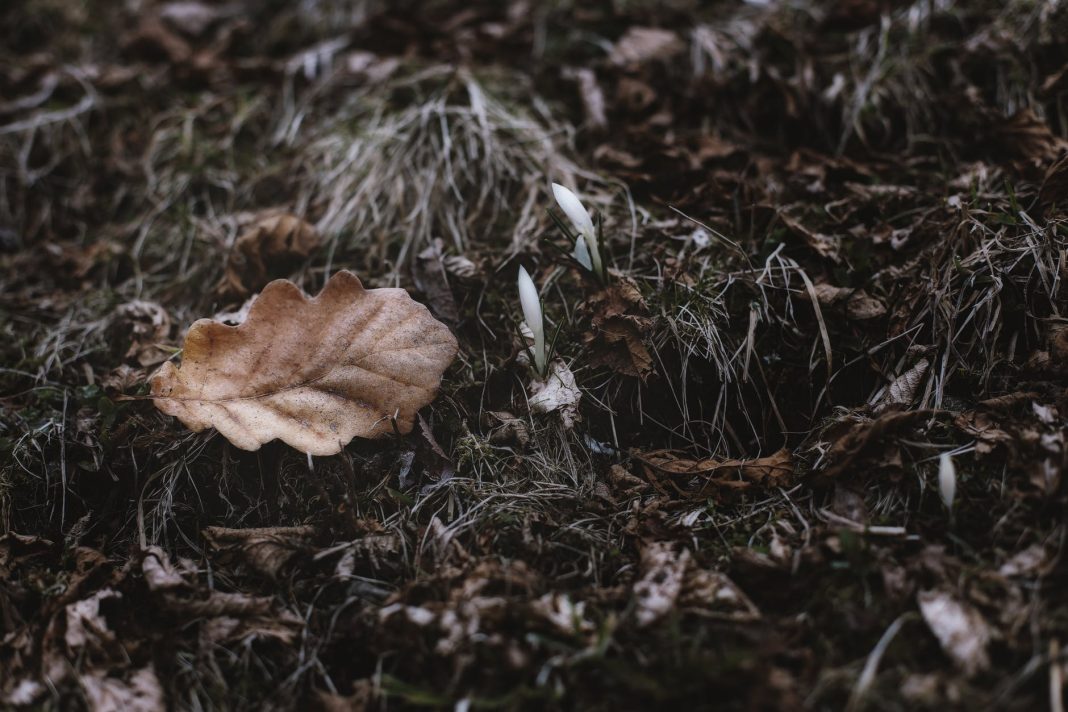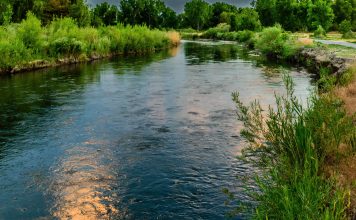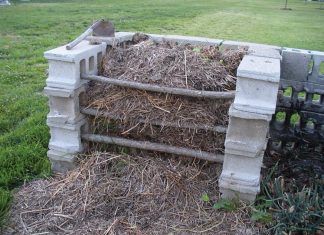 |
|
| Issue #95 • September/October, 2005 |
During the crispy fall afternoons, we listen often and intently to the weather forecasts. “It’s going to be clear tonight,” I’d tell my late husband, Bob, and my son, David. “It could frost….” So we cover everything that is not frost hardy. Everything that we can, that is. The rows and rows of sweet corn, beans, and potatoes will have to tough it out. We just don’t have enough “cover” to cover them. We drag out the huge plastic tarps we’ve salvaged from the throw away bin at a truss mill, blue and green cheapy tarps, old clear plastic, feed sacks, rugs, old blankets, saddle blankets, buckets, and anything that will protect our precious tomatoes, peppers, and melons. Working until after dark sometimes, we desperately tuck our plants in for the night. We drag into the house, knowing we’ve done everything we can. Sometimes it frosts, other times we get lucky and the Frost Fairies bypass our patchworked and ugly garden for easier targets.
The process is repeated several times each fall. Often the first frost comes early, leaving a good bit of Indian summer behind it. This adds weeks to the growing season at the peak of production. We don’t want that first frost to cut us off early. And since we eat what we grow, this is vital to our family.
|
But as the autumn colors bloom about us, those chilly nights become sharper and the air clearer until the weather radio doesn’t warn of frosts. It calls for a freeze. This differs from a frost in that you can’t simply cover your plants to protect them as you can for frost. With a frost, anything you are able to cover will usually survive and go on to produce. So when we hear the dreaded “F” word, we pull out all the stops and gather what we can, for after the freeze most of your garden is nothing more than soggy, drooping black vines full of frozen, useless vegetables.
We pick all of the tomatoes and peppers of any size. Even the egg-sized fully green tomatoes will be used for relish, green tomato pie (lookup my “fake” apple pie recipe in Issue #77, Sept/Oct 2002), dill green tomato pickles, and more. I pick the tomatoes carefully, sorting them by ripeness. The red-ripe ones together, the yellow-orange ones together, and so on down to the rock-hard little green guys. The reason for this is that the tomatoes will easily and swiftly finish ripening in the house with no special help. I don’t put them in a sunny window, wrap them with newspaper or anything. I just sort ’em and stack the pails, kettles, boxes, and baskets in rows in any warm place I can: the kitchen floor, the pantry, or even on my son David’s lower, unused bunk bed.
Likewise, all the beans are picked along with any ripe melons. Melons don’t ripen much indoors, so it isn’t a good idea to harvest little ones. They will only rot. Every cuke of any size is picked, from tiny pickler to salad slicers. Even a light freeze will kill the plants even when covered, leaving the fruits of the vine soft and unusable. Squash and pumpkins are loaded into the garden cart and toted into the goat barn. They will survive lighter frosts, uncovered, but the freeze will make them soft and they will quickly rot. Every ear of sweet corn is picked and brought in to process as soon as I can. Corn doesn’t take freezing well, and sometimes a light frost will “burn” the plants, leaving the corn leaves first dark, then yellow brown on the edges.
|
After such a frost, or before a freeze, the corn must be quickly picked and processed to keep it sweet and tender. Even a couple of days on the dead stalk will often result in tough corn with little sweetness or corn taste.
We work like dogs, knowing that this is about it for our biggest part of the harvest. The onions, carrots, and potatoes are safe from all but a dreadfully hard freeze. The cabbage family, including broccoli, cauliflower, and Brussels sprouts are fairly safe, but we always cover the cauliflower and broccoli, just to be sure, as a sharp freeze can damage these crops.
Even after a good freeze, it seems like there are some “hangers on” in the garden, some green tomatoes that survive under the now black vines to go ahead and begin to ripen, a few bits of this and that, so we still watch the garden and harvest what we can.
But finally, it’s about done. The root crops are dug, the cabbage, broccoli, and late onions are harvested, and the garden stands tattered and worn. After a season’s hard work, culminating in the mad pre-freeze harvest, we are ready to rest a bit.
But this is not to say we are done gardening for the year. For it’s time to put the garden to bed for the winter.
Get rid of dead plants
Most of the “ugly” in the garden now is jutting, broken, black and brown dead plants, looking used and sad. Some gardeners simply till under all of the garden plants. Of course this is a simple fix to the problem, and it does add some organic material to the soil. But there are times that this is not the best idea. First of all, think about any insect problems you have had in your garden this year. Many of these nasty pests breed and stash their eggs in the stems and roots of the very plants they infested.
How about cukes that had white powdery spots on leaves, or beans whose vines yellowed and wilted? Or tomato vines that had yellow spots, black dots, or wilted and died? These are all signs of diseased plants. To simply till them under just about guarantees that you’ll have the problem again next yearand probably worse.
|
What I do is gather any such plants into a pile in the center of the garden and burn them on a safe day, usually when it has snowed. I make sure that every corn stalk, every vine is burned to white ash, even if I have to add some light dry brush for fuel. Let corn ear worm eggs or powdery mildew survive that!
Another time to either compost or burn heavy garden waste is when you live in the dry climates, such as we had in New Mexico. There, I opted to chop and compost my corn stalks because it took years for such heavy material to finally rot away. And un-rotted, it tangled tiller tines and was a possible home for garden insect pests.
Don’t worry that you will waste this material because the ash generated from burning it is a good addition to your garden, being high in potash. In fact, we liberally sprinkle our ash from the wood kitchen range across the garden each year.
Add organic material
Before you till that garden plot the last time in the fall, add as much organic material as you can. I doubt that it is possible to add too much, if the material is right. You don’t want to put a foot of raw manure without bedding onto the garden. If you do, your next year’s garden will appear fantastic, but your crops will be huge plants and vines, and little fruit due to the high nitrogen content of the raw manure.
Instead, use at least partially rotted manure with a decent amount of straw or sawdust bedding mixed with it. This will provide plenty of organic fertilizer, and the straw or sawdust bedding will help tame the excess nitrogen and add extremely valuable compost to improve the tilth of the soil.
Another easily added natural material that will do this is bushels and bushels of leaves. If you don’t have enough leaves of your own, gather bags of them from the curb in your town. I used to have a “leaf route,” which was simply a lot of town folks who loved to have me stop once a week and throw their bags of leaves into my truck to use on the gardens instead of paying to have the trash haulers take them away. It was a simple word-of-mouth thing. In the late summer, I just told a few people on a few streets that I needed more leaves for my garden and would happily pick them up. By the time the first flush of leaves hit the ground, I had a list of 15 people who wanted me to stop regularly. And that doubled as other neighbors saw what was going on. It seemed that even town people were tickled to see their leaves go to a good use.
You can spread a foot of leaves on your garden, then either wait for a good rain to mat them down or water the garden well. When it dries enough to till, run the tiller through them until they are chopped up and buried. Then you can wait a few days and do it again. The leaves rot very quickly, and it’s amazing how many leaves you can work in each fall. (Plus, you have garbage bags enough for your trash all winter.)
|
With your strawy manure, dump six or eight inches over the garden area and till that in well. You can add another layer, as you did with the leaves, except on the area where you will plant your potatoes next spring. If you get this area too rich in nitrogen, your potatoes will be quite prone to scab, making them unappetizing as well as lower producing.
Want a “different” soil amendment that is also free for the taking? You folks who live in the country can go talk to your local grain elevator (not feed store) manager. Ask him if they haul away screenings. Screenings are grain hulls, bits and pieces of husk, straw, and leaves, as well as broken bits and pieces of grain, left over after corn, oats, and other grains are run through a screen to clean them for market. Sometimes there are even piles of wet or sour grain that has spilled when trucks are unloaded. Tell him that you are looking for this to add to your garden soil. In grain producing areas, truckloads are often available free. Watch out for concentrated weed or other seeds in screenings, as you can easily “seed in” a great patch of weeds. Once in a while you’ll see lots of seeds in screenings. Feed these to your chickens or soak them well in an old trough to sour them, then dump them in your compost pile to rot.
My first homestead was located only two miles from a small town with a large grain elevator. They were thrilled to be able to have their dump trucks haul their “refuse” to my place, just to get rid of it. I had so much that I had to hire a fellow with a small bulldozer to come and work the mountains of rotting grain into the ground of my garden and pasture.
It sure smelled high that fall. But when spring came, it had all rotted and turned my garden from a sandy piece of worthless ground to heaven on earth. I tilled the ground and found it deep and black, crumbling behind my tiller like we’ve all dreamed of. It was so productive that my first year was unbelievable. And when I wanted to fish in the river across the road, I could literally take a stick, poke it into the ground and flip out enough worms to fill a soup can in a couple of minutes. That’s God’s truth.
Likewise, my first garden in Minnesota, back in 1972, was on solid red clay, down eight feet or more. I had to plow with a tractor to get my root crops out of the ground. It was that hard. Now that wouldn’t do. So I borrowed a manure spreader and spent two weeks hauling a mountain of old black cow manure from beside the old barn right out onto the garden. Everyone said I’d “burn” the garden plants right up. But I remembered the results of the grain screenings and figured that anything was better than that red clay.
Turns out that I was right. The next year’s garden was much better, and the carrots could be dug, not plowed up at harvest. But every year, for the next 15, I hauled many loads of strawy manure out there and worked it in. And, of course, the truckloads of bagged leaves. When I left, the soil was black, crumbly, and you could not dig deep enough to get down to red clay without a backhoe.
Should you be in an area where the soil is acid, it’s also a good idea to sprinkle lime over the garden as you work in this material. Acid soil is found where you see wild strawberries, wild blueberries, and moss growing across the ground. Of course, it’s best to take a simple soil test to find out exactly how acid or alkaline your soil is, for most plants like a fairly neutral soil to thrive in.
|
Enlarging your present garden
Fall is the best time to enlarge your garden for next year. This gives time for the sod and plants that you’ve tilled under to rot, making tilling and planting next spring much, much easier. Haul away any logs and large debris. Dig any stumps that you can. (Don’t let a few that remain daunt you, though. Just plant around them and cover them with small compost piles to help them rot quicker.)
Like your main garden plot, till it in, digging out as many weed and brush roots as possible to help avoid weed problems next year. Then work in as much organic material as you can, such as strawy manure, compost, or leaves. This will quietly rot during the winter, making the soil happy and healthy.
Do you need to fence your garden? Fall is the perfect time to get this done, before the rush and craziness at planting time. Deer need at least a six-foot fence, with another foot or more of top wires above that. Rabbits usually will keep out of 2″x 4″ wire, but I’ve stood in the garden and watched an adult cottontail scurry through it. Heavy-duty chicken wire is safer. I’ve had good luck with 6-foot high 2″x 4″ welded wire with a two-foot bunny and ground squirrel chicken wire run around on the outside of the welded wire. This pretty well keeps out everything but chipmunks and birds.
How about trellises for grape vines, hardy kiwis, and so forth? If these are in your plans, this is a good time to get them placed in the ground. That way they will be firmly set long before you plant your vines in the spring.
By now, your garden is wonderfully cleaned up, fed, groomed, and tucked into bed for the winter. The new fence is up and you and your garden are ready for a good winter’s rest. I sometimes believe that God gave us winter so we would be forced to take it easy for awhile. Walk out and pat those wonderful beds before it snows and tell them to have a great winter.
Before you know it, you’ll be getting those seed catalogs in the mail and you’ll get the fever again. It happens to me every single year.




















I’ve read about the no-till method, have done it in Herrick Kimball’s minibeds gardening, and of course, in Paul Gautschi’s Back to Eden gardening. The most important idea in these methods is not to disturb the ‘biomass’ community underground; those that service your plant roots with moisture and mineral-nutrients. This past year I had a row garden, too, and dug trenches where I put my rows and put in lots of oak leaves/needles, cow manure, a little of chicken manure, sand, and compost to amend the mostly clay dirt, like you described in your article. I also used lime powder mixed with borax soap for the boron content, that I read keeps the lime from binding with the dirt molecules and then cannot be up-taken by plant roots as calcium. Anyway, wouldn’t it be the best to no-till, now that it’s soil?